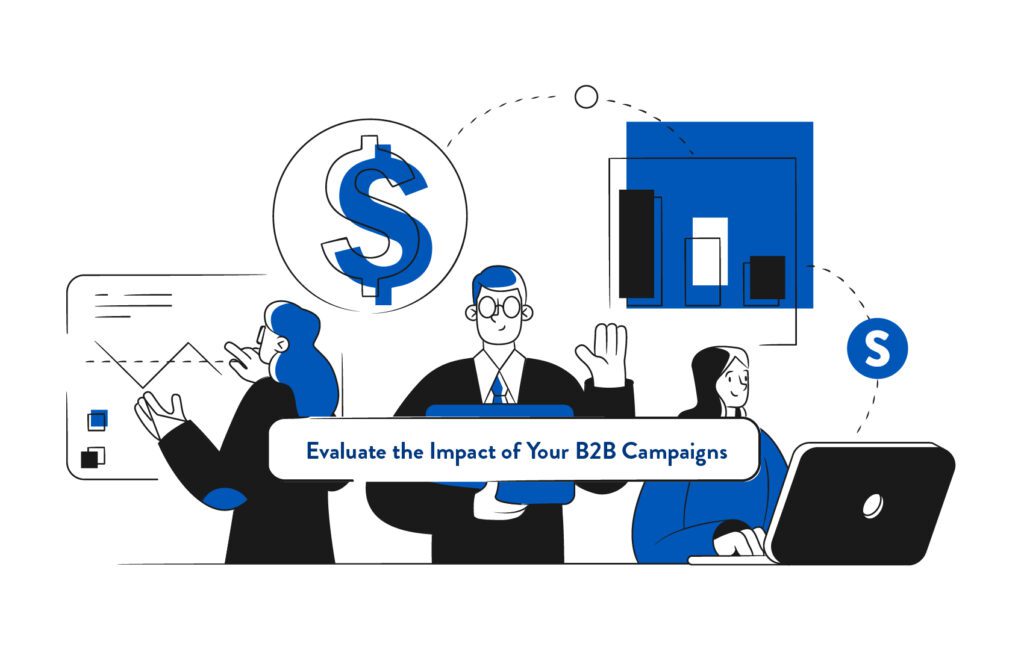How to Evaluate the Impact of Your B2B Advertising Campaigns

Launching a B2B advertising campaign is just the beginning. To ensure your efforts are driving the desired results, it’s crucial to measure and analyze the success of your campaigns. However, measuring success in B2B advertising can be complex, involving multiple metrics and long sales cycles. In this blog, we’ll explore the key performance indicators (KPIs) and methods you can use to evaluate the impact of your B2B advertising campaigns.
1. Set Clear Objectives and Align Metrics
The first step in measuring the success of your B2B advertising campaigns is to establish clear objectives. Are you aiming to generate leads, increase brand awareness, or drive conversions? Each goal requires different metrics for evaluation. For example, if your primary goal is lead generation, you’ll want to track metrics like cost per lead (CPL) and conversion rates. For brand awareness, metrics like impressions, reach, and engagement are more relevant.
Actionable Tip: Before launching your campaign, outline your specific objectives and select the KPIs that will help you measure progress toward those goals. This ensures that your analysis is focused and relevant.
2. Track Lead Generation and Conversion Rates
Lead generation is often the primary goal of B2B advertising. To measure success in this area, track the number of leads generated through your campaigns and the conversion rates of those leads. It’s important to go beyond just counting leads—consider the quality of the leads as well. High-quality leads are more likely to convert into paying customers, making them more valuable to your business.
Key Metrics:
- Cost Per Lead (CPL): The amount you spend to acquire a lead. A lower CPL indicates a more efficient campaign.
- Conversion Rate: The percentage of leads that take the desired action, such as filling out a form or making a purchase.
- Lead Quality: Assess the potential value of the leads based on criteria such as company size, industry, or decision-making authority.
3. Analyze Engagement Metrics
Engagement metrics provide insight into how your audience is interacting with your ads and content. High engagement rates indicate that your message is resonating with your target audience. For B2B advertising, key engagement metrics include click-through rates (CTR), time spent on landing pages, and social media interactions.
Key Metrics:
- Click-Through Rate (CTR): The percentage of users who click on your ad after seeing it. A higher CTR suggests that your ad is compelling and relevant.
- Time on Page: The amount of time users spend on your landing page after clicking on your ad. Longer time spent indicates that the content is engaging and informative.
- Social Media Engagement: Likes, shares, comments, and other interactions on platforms like LinkedIn can provide valuable feedback on the effectiveness of your content.
4. Monitor ROI and Cost Efficiency
Return on investment (ROI) is a critical metric for evaluating the overall success of your B2B advertising campaigns. ROI measures the revenue generated from your campaign relative to the cost of running it. A positive ROI indicates that your campaign is profitable, while a negative ROI suggests that adjustments are needed.
Key Metrics:
- ROI: (Revenue – Cost) / Cost: This metric helps you understand the financial impact of your campaign.
- Customer Acquisition Cost (CAC): The total cost of acquiring a new customer through your campaign. A lower CAC indicates greater cost efficiency.
5. Use Multi-Touch Attribution
B2B buying cycles are often long and involve multiple touchpoints. To accurately measure the success of your campaigns, it’s important to use multi-touch attribution. This approach assigns value to each touchpoint in the buyer’s journey, helping you understand which channels and interactions are most effective in driving conversions.
Actionable Tip: Implement multi-touch attribution models in your analytics platform to track the full customer journey. This will give you a more comprehensive view of how your ads contribute to conversions over time.
6. Gather Qualitative Feedback
While quantitative metrics are essential, qualitative feedback can provide additional insights into the success of your B2B advertising campaigns. This feedback can come from sales teams, customer surveys, or direct communication with prospects. Understanding how your audience perceives your brand and messaging can help you refine your approach and improve future campaigns.
Actionable Tip: Conduct regular surveys or interviews with leads and customers to gather feedback on their experience with your ads and content. Use this feedback to make data-informed adjustments to your campaigns.
Conclusion
Measuring the success of your B2B advertising campaigns is essential for optimizing performance and achieving your business goals. By setting clear objectives, tracking relevant KPIs, and using tools like multi-touch attribution, you can gain valuable insights into what’s working and what needs adjustment. Remember to combine quantitative data with qualitative feedback to get a holistic view of your campaign’s impact. With these strategies in place, you’ll be well-equipped to refine your B2B advertising efforts and drive better results for your business.
To read more tips on B2B marketing strategies, check out our other B2B articles. If you’re interested in partnering with STORY to optimize your current marketing efforts, visit our website to learn more about our marketing services.